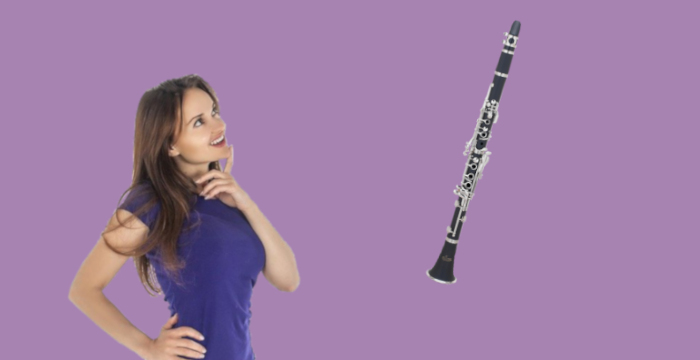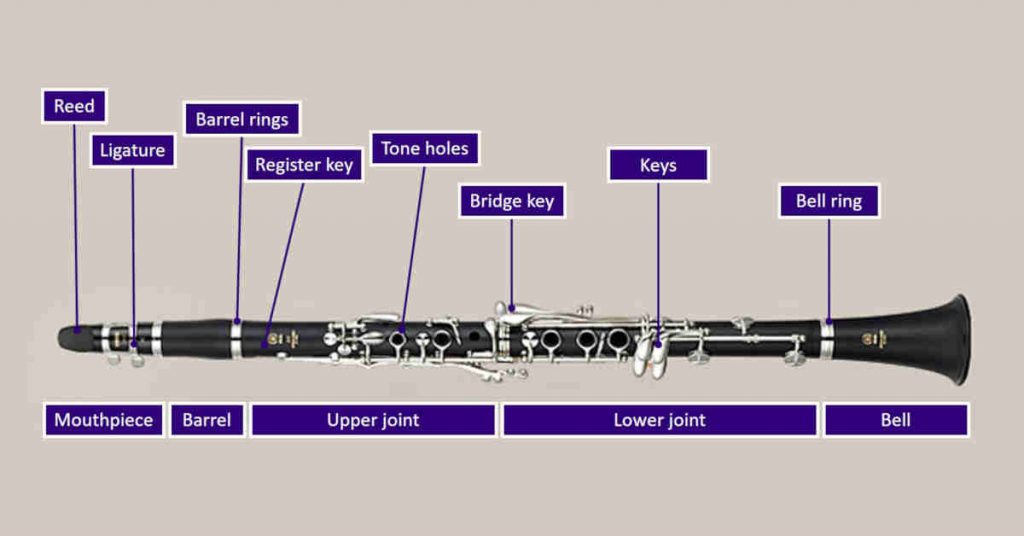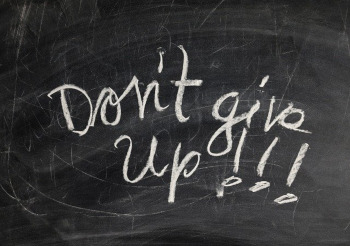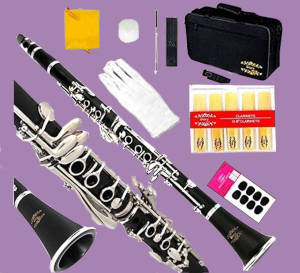
This post may contain affiliate links and we may receive compensation if you purchase products linked to below. As an Amazon Associate, we can earn from qualifying purchases. Please see our Terms and Conditions for details.
Are you curious whether the Allora AACL-336 clarinet is the right clarinet for you or someone you know? Are you tired of Allora clarinet reviews that try to “sell” you on any model they can?
Well, I won’t tell you this is the perfect clarinet for you. And I’m not here to put it on a pedestal and ignore its faults.
Instead, I promise to help you make your own buying decision by exposing the good, the bad and the ugly of this Allora B-flat clarinet. You’ll discover what criteria are important when choosing a clarinet and how this model stacks up for each.
The Allora brand
Let’s first talk about the Allora brand. Their instruments are sold in several mainstream American retail stores. And you’ll find they’ve obtained mostly favorable customer reviews.
Apart from other woodwinds like bassoons, Allora also manufactures a wide range of brass instruments. Trombones, tubas, trumpets, saxophones, French horns, flutes and even piccolos carry the Allora name.
Not much is publicly known about the Allora brand. I actually contacted them through their website with a list of questions a few days ago but haven’t gotten a response as of this writing.
They may be an American company, as their website lists a contact address in California.
Key criteria for rating the Allora AACL-336 clarinet
Let’s get into the specific points to consider when rating a clarinet to decide whether the Allora AACL-336 is your ideal choice.
Pros
- Good feel and handling
- Decent sound
- Durable keys
Cons
- Some reports of air leaks
- Limited accessories included
- “Stuffy” sound can occur
1. Price
Even if you’ve set yourself a liberal budget for buying a clarinet, you likely want to get the best clarinet for your money.
This Allora student clarinet is priced in the mid range. Expect to pay between $280 and $350 for a new model.
You can get a much cheaper model for under $100. But then again, higher-end student models often sell for as much as $1,000 or more.
There’s a lot more to consider than price alone. So unless the AACL-336 is way outside your budget, I suggest you consider the other criteria.
2. Play-ability
This is a big point, especially when you’re looking for a student clarinet. Wooden professional clarinets tend to be harder to play than student or intermediate models. But an experienced professional clarinetist can normally handle them quite well.
Whereas for someone learning to play clarinet for the first time, the easier their clarinet is to play, the better. Learning on a difficult model can frustrate beginners and hold them back.
The play-ability of the Allora AACL-336 is mixed. Its lightweight ABS body makes this model easier to handle than some alternatives. But some musicians report issues, including:
- Air leaks from the pads covering the tone holes.
- Difficulty blowing air through the mouthpiece to produce a sound. Upgrading the stock mouthpiece for $20-30 should make it easier to play.
- Tenon corks are too tight. Although not an uncommon issue among new clarinets, this can make assembling and disassembling a clarinet difficult. Carefully trimming or sanding down the corks should help.
You can find pricier models that offer better ease of play than this Allora student clarinet. But its play-ability is generally in line with its price.
3. Clarinet durability
Who you’re buying a clarinet for and where it will be played largely decide how important durability is when choosing a clarinet.
Parts made with different materials and quality of workmanship have a direct impact on how long an instrument lasts and how often it needs maintenance. So some basic understanding of the different parts of a clarinet will be relevant as we discuss durability.

Body
Several pieces come together to make up the main assembly of a clarinet, collectively called the body. You’ll probably want a clarinet with a durable body, depending on the circumstances.
Durability is an advantage, for instance, in a clarinet belonging to a young child. A clarinet in the hands of a child is more likely to be dropped, knocked around and handled roughly. Likewise, a clarinet being played outdoors needs to be hold up to changes in temperature and humidity.
The Allora AACL-336, with its ABS resin body, is ideal in both cases. Unlike wooden models, it’s more forgiving to rough handling and won’t warp or crack if played outdoors.
Pads
The pads of a clarinet form airtight seals over the tone holes of the instrument to allow the musician to play different notes.
The Allora student series AACL-336 comes equipped with double bladder fish skin pads. Leather, the other material commonly used for pads, tends to last a bit longer than fish skin but can cause pads to stick to the tone holes.
Neither material is objectively better than the other. And with proper care, the pads on this Allora student clarinet should last 2-3 years or more.
Keys
A clarinet’s keys work like levers under the player’s fingers to press or release the pads over the tone holes.
The main concern with keys is quality of workmanship and materials. Many lower-end clarinets have delicate keys that easily bend or break during normal play.
The Allora AACL-336 hassolid nickel-plated keys. You shouldn’t have to worry about them falling apart, as long as they’re handled with care. And although not as shiny as silver-plated keys, nickel-plated keys are usually less expensive without compromising durability.
4. Sound
Tone and projection are the main qualities concerning sound to look for in a clarinet. The best clarinets have a rich, even tone across the full range of notes and a clear sound that carries.
Don’t expect quite the evenness in tone with this Allora clarinet that you’d get from a higher-end student clarinet, such as the Buffet Prodige. A few musicians have reported that some notes—in particular, the thumb F—are a half step out of tune and that the AACL-336 can sound a bit airy or muffled.
But this clarinet has generally been well received for its sound and has even pleasantly surprised some band directors.
5. Commitment to playing clarinet
This next point, though not a direct feature of clarinets themselves, deserves some consideration.
Playing clarinet, as with many hobbies, can be quite fun. But learning to play clarinet well, takes long, focused effort.

Making mistakes is unavoidable. And in their failures, new students often get embarrassed or frustrated with the instrument. And they’ll need to overcome their embarrassment and frustration if they’ve any hope of making progress.
Commitment to playing becomes relevant when considering which clarinet is best for you.
For example, maybe you’re buying a clarinet for a student who has owned one or two models before and has been playing for a couple years already. I might suggest spending a bit more on a nicer model in this case, as he or she could probably appreciate the difference in quality and is likely to continue playing for years to come.
Then again, maybe you’re buying a clarinet for a first-time musician or a young child whose interests are harder to predict. In these cases where you may have doubts about the commitment to playing, I’d say the Allora student series AACL-336 is a solid choice.
6. Accessories included with the clarinet
Most new student clarinets come with some accessories. These extras can be nice to have, especially if you don’t know what accessories you’ll need to get started.
Besides including the basics like a reed, mouthpiece and carrying case, some clarinets also include a stand, a reed holder, a cleaning kit and more.
But in my experience most sellers include these “free” items to make a cheaper clarinet appear more attractive. These items don’t tend to be well made. And you’re usually better off buying better alternatives separately.
Depending on where you buy an Allora AACL-336, it will generally include:

- 1-2 starter reeds
- Cork grease
- Cleaning cloth
- Mouthpiece
- Cap
- Carrying case
These should be enough to get a clarinetist started. Though there are a couple caveats with the reeds and mouthpiece:
Reeds
As with most starter reeds, don’t expect great quality. And since the reed used can have a surprising impact on play-ability, you might just want buy a separate set upfront (my go-to recommendation is Rico 2.5 strength reeds).
Mouthpiece
The stock mouthpiece included with this instrument has received mixed reviews. Some have commented that blowing air through it to produce a sound takes more effort than expected.
My advice here is to try the clarinet first and see how it plays. Then consider upgrading the mouthpiece (Yamaha’s 4C mouthpiece is a good-value option) if you meet a similar problem.
7. Manufacturer’s warranty
If, by chance, the clarinet you ordered arrives to you damaged, you may not have any recourse. That is, unless it’s under warranty.
A product warranty is an added bonus for a new clarinet. Especially when the clarinetist is new to the instrument and hasn’t yet gotten used to handling it, a warranty that protects against damage can save you the cost of repairs or replacement.
Allora gives original buyers a 3-year warranty for all their wind instruments guaranteeing no defects in workmanship or materials. The warranty excludes components like springs, pads and corks. So if the joints of your Allora clarinet fit too tightly and you choose to trim down the corks, be extra careful.
Specifications
Here’s a rundown of the key specifications for the Allora student series AACL-336:
- Bore: Cylindrical / 0.577″ (14.66mm)
- Key of: Bb
- Fingering: Boehm
- Body material: ABS resin
- Pads: Double bladder fish skin
- Plating: Nickel
- Mouthpiece: Stock mouthpiece
- Case: Molded case
- Springs: stainless steel
The bottom line: Is this Allora clarinet your ideal choice?
The Allora AACL-336 clarinet is a decent instrument. Its durability, overall quality sound and manufacturer warranty, all at a reasonable price, help make it one of the best-value student clarinets available.
If you’re less concerned about price and just want the best student clarinet possible, there are better options at the higher end. Similarly, if you’re just looking for a toy clarinet that barely plays notes but won’t cost more than $100, this isn’t the clarinet for you.
But this is a perfectly good choice if you’re someone who wants a decent starter clarinet that plays reasonably well and will last a couple years or more.
I’ve been a drummer for over 50 years. In High School I played Clarinet because there were already too many drummers. I’m retired and want to play Clarinet again. I play drums at Church, but I would like to hear music. I saw an Allora Clarinet with the backpack/case on Marketplace for $75. I’ve never heard of that brand. The seller states that it is a year old. Just from the picture, it looks good and the cork seems to be intact. Do you think it would be worth the $75 or should I save more money and buy a Selmer or other upgrade. I plan on playing it in Church and home. Thank you